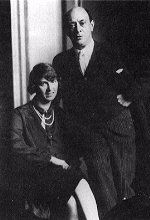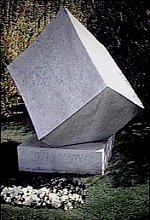| [naar
inhoudsoverzicht muziekgeschiedenis]
[naar
inhoudsoverzicht korte biografieen]
[naar Schoenberg-
biografie
1]
[terug naar inhoud
Schoenberg-biografie 2]
[naar
literatuurlijst]
inhoud:
|
1914-1951
1914 - World War I
These first successes were wrecked when World War I broke out. Drafted
into the army in 1915 , Schönberg had not much time for his
work. After the training at the reserve officers' school in Bruck an der
Leitha, though he was temporarily exempted from military service in 1916,
he was drafted again in 1917 and assigned to the military band.
During the war years he worked at the unfinished oratorio „The
Jacob's ladder", in which he inserted his theosophical religious ideas.
1918 - Verein für musikalische Privataufführungen
(society for private music performances)
After the end of the war, Schönberg founded the „Verein für
musikalische Privataufführungen" (society for private music performances),
a new forum for modern music. The goal was to create ideal preconditions
for the performance of contemporary works. Compositions by Schönberg,
Berg and Webern, but also other composers were presented in private circles,
while doing so the national ditches, which the First World War has run,
were surmounted at least at artistic level by the international connections
of the society.
1920 - The twelve-tone technique
From 1920 to 1923, Schönberg attended to a new
composition method based on the twelve tones of the chromatic scale. The
so-called „twelve-tone technique" („dodecaphony" or „twelve-tone music")
is based on the principle that each tone of these twelve-tone series can
only be repeated when all the other eleven tones were heard.
These „series" can be used in basic form as well as in inversion
(mirror-inverted process), as retrogression (true-to-note retrogressive
version) and in retrogressive inversion (mirror-inverted process of the
retrogression). Since new series can be raised on each tone of the series
(transposing), 44 series at the most develop from one twelve-tone series.
At the same time as Schönberg - and without knowledge from
each other - the Austrians Joseph Matthias Hauer (1883-1959) and Fritz
Heinrich Klein (1892-1977) were experimenting with similar composition
procedures. Schönberg had in this context provable knowledge of Klein's
discoveries, but „forgot" them allegedly over the work on his own theory.
After having finished the „Fünf Klavierstücke" op 23
and the „Serenade" op 24, Schönberg's „twelve-tone technique" became
known for the first time for the „Suite für Klavier" op 25 (1923).
A controversy between Schönberg and Hauer followed, but it was fruitless
despite reciprocal conciliatory efforts. However, Fritz Heinrich Klein,
cut dead and thrust into the artistic isolation by the circle around Schönberg,
fell into oblivion.
1923 - International recognition
Mathilde Schönberg died in autumn 1923, an event to witch he erected
a monument by the text draft of a „requiem".

Mathilde and
Arnold Schönberg in 1922
He found international recognition through the first performances of
the one-act plays „Erwartung" and „Die glückliche Hand" and concerts
at the music festival in Donaueschingen, followed by the appointment to
the chair of a master class for composition at the academy of arts of Berlin
and the honorary membership of the Academia Santa Cecilia in Rome in 1925.
The compositions of this time, the „Quintett" für Bläser
op 26, the „Vier Stücke für gemischten Chor" op 27 and „Suite"
op 29 (finished in 1926), are determined by the problem of the mutual influence
of form and musical material.
1924 - Master years in Berlin

Gertrude and
Arnold Schönberg
Schönberg married Gertrude Kolisch in 1924 and moved to Berlin
in 1926. He composed here among other works the „Variations for orchestra"
op 31, first performance in 1928 by Wilhelm Furtwängler, „Begleitmusik
zu einer Lichtspielszene" op 34, the 3rd string quartet op 30 and the satirical
opera „Von heute auf morgen" op 32 (text: Max Blonda, a pen name of Gertrude
Schönberg-Kolisch).
In 1930, Schönberg began to work on the unfinished opera
„Moses and Aaron". He continue this work during his long sojourn in Spain
in 1931. In Spain, Schönberg and his wife met also the famous cellist
Pablo Casals.
1932 - Emigration to the USA
After Adolf Hitler's take-over in 1933, Schönberg was dismissed
from the Berlin academy. He emigrated with his wife and his daughter Nuria
at first to Paris, where he was converted to Jewish faith (Marc Chagall
was his witness), then to the USA, where he worked as musical educator
at the Malkin Conservatory in Boston, Massachusetts. In 1934, he
moved to Los Angeles, gave private lessons and lectures at the University
of Southern California (USC) and held a chair at the University of California
(UCLA) since 1936.
In addition to the „Violin concerto" op 36 and the 4th string
quartet op 37 (both of 1936), he composed in the USA also the 2nd chamber
symphony op 38 (1939, begun in 1906), the „concerto for piano and orchestra"
op 42, the „Kol Nidre" op 39 (1938), Schönberg's most devout confession
of Jewish faith, and the „Ode an Napoleon Bonaparte" op 41 (1942, text:
Lord Byron), a bitter accusation against dictatorship and tyranny.
1940 - American exile
In 1940, Schönberg became American citizen. Although his financial
situation was very bad despite regular teaching, his application for the
popular Guggenheim postgraduate scholarship was turned down and he had
to continue to give private lessons also after his retirement (his pension
amounted to 38 $!), Schönberg had not the intention of returning to
Europe after the end of war. Even the bestowal of the honorary citizenship
of his native town Vienna (1949) and the official invitation to participate
actively in the cultural recovery of Austria could not induce him to come
back. In 1946, he suffered a heavy cardiac infarct. During his recovery
he composed the „string trio" op 45, which may be read as a record of his
disease. The cantata „Ein Überlebender aus Warschau" op 46, composed
in 1947, which gives expression to Schönberg's dismay when the holocaust
in the German and Austrian concentration camps became known, can also be
interpreted as biographic.
1949 - The last years
In 1949, a controversy arose between Schönberg and Thomas Mann
after the publication of his novel „Doktor Faustus". In this work, Mann
ascribed a composition method with twelve tones to the fictitious „tone
setter" Adrian Leverkühn. Schönberg felt cheated out of his intellectual
property. Even Thomas Mann's subsequent preliminary remark in the novel
referring to Schönberg's authorship could not calm him. The dispute
was only settled in 1950.
In the meantime, Schönberg continued to compose untiringly.
In addition to a „Fantasy for violin with piano accompaniment" op 47 he
composed three choir pieces, the last one with speaker and orchestra accompaniment:
„Dreimal tausend Jahre" op 50a, „De profundis" op 50b and „Modern psalm"
op 50c. In the anthology of essays „Style and Idea" he pointed out his
aesthetic opinion.
On July 13th 1951 Schönberg deceased in Los Angeles,
conscious of the fact „that a full understanding of my works can not be
expected for several years."

|